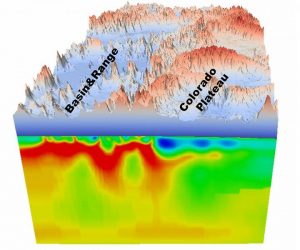
Credit: Image by Lijun Liu
An advanced imaging technique used to map Earth’s outer shell also can provide a measure of strength, finding weak spots and magma upwellings that could point to volcanic or earthquake activity, according to a new study by geologists at the University of Illinois at Urbana-Champaign and the University of Adelaide in Australia.
The researchers developed a method for measuring strength and finding weak spots in the lithosphere, the outer layers of earth that include the crust and the outer mantle — the molten rock lurking just under the surface that can well up and create volcanoes. The researchers found that calculating lithosphere strength using magnetotelluric imaging maps of the southwestern United States can more accurately describe the rough terrain and volcanic and seismic activity observed on the surface than can standard geologic models.
The study by U. of I. geology professor Lijun Liu and Adelaide professor Derrick Hasterok is reported in the journal Science.
“According to plate tectonics, the standard theory of earth science, the lithosphere is supposed to be rigid. But we know that is not the case,” Liu said. “We know that a lot of places like the western U.S. have frequent fault-slip earthquakes and very rough surface topography, and are tectonically active. In this paper, we propose a new way to describe the mechanical properties of Earth’s lithosphere.”
Magnetotelluric imaging is a high-resolution mapping technique that the National Science Foundation has used to scan the lithosphere beneath much of the U.S. It provides information about the electrical conductivity of the lithosphere, which Liu and Hasterok were able to use to calculate strength and its variations from place to place.
“The same factors that affect electrical conductivity — temperature, water content and the presence of molten material — also affect the viscosity or strength. The hotter, wetter or more molten, the weaker the structure,” Liu said.
The detailed models produced using the MT imaging data of the southwestern U.S. more accurately portrayed surface structures at a scale of less than 100 kilometers, Liu said, which is important because features like volcanoes and faults are localized phenomena that are harder to predict using larger-scale models. The models depicted upwellings in the mantle and peaks in the topography that correlated to features in the terrain and active volcanoes.
The researchers believe that analyzing lithosphere strength using MT images now being collected around the world can open new avenues of understanding the dynamic mechanisms of the Earth and its seismic activity.
“This method will aid our understanding of the processes that cause earthquakes and volcanic activity,” Hasterok said. “We’ll be able to see why earthquakes and volcanoes have occurred in the past and look for places where they might potentially happen in the future.”
Reference:
L. Liu, D. Hasterok. High-resolution lithosphere viscosity and dynamics revealed by magnetotelluric imaging. Science, 2016; 353 (6307): 1515 DOI: 10.1126/science.aaf6542
Note: The above post is reprinted from materials provided by University of Illinois at Urbana-Champaign.










